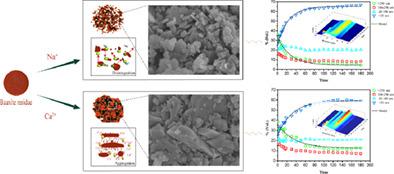当前位置:
X-MOL 学术
›
Land Degrad. Dev.
›
论文详情
Our official English website, www.x-mol.net, welcomes your
feedback! (Note: you will need to create a separate account there.)
Evaluating aggregate stability, surface properties and disintegration behavior of bauxite residue induced by Ca/Na
Land Degradation & Development ( IF 3.6 ) Pub Date : 2020-10-02 , DOI: 10.1002/ldr.3703 Shengguo Xue 1, 2 , Wenshun Ke 1 , Feng Zhu 1, 2 , Jiarong Fan 1 , Qiongli Wang 1 , Zheng Liu 1 , William Hartley 3
Land Degradation & Development ( IF 3.6 ) Pub Date : 2020-10-02 , DOI: 10.1002/ldr.3703 Shengguo Xue 1, 2 , Wenshun Ke 1 , Feng Zhu 1, 2 , Jiarong Fan 1 , Qiongli Wang 1 , Zheng Liu 1 , William Hartley 3
Affiliation

|
Bauxite residue, a typical industrial solid waste which contains a large amount of Na+, is usually physically degraded. Understandings of aggregate formation, which is a critical process in soil development, are essential to facilitate ecological rehabilitation on the disposal areas. However, few studies have investigated the aggregation behavior and mechanisms of key salt ions (Ca2+ and Na+) in residue aggregates. Therefore, an integrated method of Le Bissonnais’ method, the combined determination method, and laser diffraction measurements was applied to evaluate aggregate stability, surface properties and disintegration behavior of bauxite residue following Ca/Na additions. With increasing Ca2+ addition, mean weight diameter (MWD) increased, indicating improved resistance to dispersion. Ca2+ had a positive effect on flocculation of silt‐size microaggregates, whilst disintegration was induced following Na+ addition. Repeated laser diffraction analysis of residue samples circulating in 50 mmol L‐1 electrolyte solution (Ca2+/Na+) provided a detailed view of the changes in particle size distribution as aggregates fragmented. The visualized three‐dimensional surface map revealed that Na+ promoted the disintegration of >250 μm aggregates into finer dispersed particles, whilst Ca2+ protected the microaggregates from fragmenting into smaller particles. Variation in electrochemical properties of aggregate surfaces affected the micro‐morphology significantly. The findings provide a new approach to specify pedogenic aggregate behavior of bauxite residue, whilst revealing the effects of Ca2+/Na+ on aggregate stability, surface electrochemical properties and its micromorphology. The results will provide a detailed understanding of aggregate behavior during soil formation process in bauxite residue.
中文翻译:

评估 Ca/Na 诱导铝土矿残渣的聚集体稳定性、表面性质和崩解行为
铝土矿渣是典型的工业固体废物,含有大量的 Na+,通常会被物理降解。了解团聚体形成是土壤发育的关键过程,对于促进处置区的生态恢复至关重要。然而,很少有研究调查残留聚集体中关键盐离子(Ca2+和Na+)的聚集行为和机制。因此,采用 Le Bissonnais 法、组合测定法和激光衍射测量的综合方法来评估添加 Ca/Na 后铝土矿残渣的聚集体稳定性、表面性质和崩解行为。随着 Ca2+ 添加量的增加,平均重量直径 (MWD) 增加,表明抗分散性提高。Ca2+ 对淤泥大小的微团聚体的絮凝有积极影响,而 Na+ 添加后会诱导崩解。对在 50 mmol L-1 电解质溶液 (Ca2+/Na+) 中循环的残留样品进行重复激光衍射分析,提供了当聚集体破碎时粒度分布变化的详细视图。可视化的三维表面图显示 Na+ 促进了 >250 μm 的聚集体分解成更细的分散颗粒,而 Ca2+ 保护微聚集体免于破碎成更小的颗粒。聚集体表面电化学性质的变化显着影响了微观形态。研究结果提供了一种新的方法来指定铝土矿残渣的成土骨料行为,同时揭示 Ca2+/Na+ 对骨料稳定性的影响,表面电化学性质及其微观形貌。结果将提供对铝土矿残渣土壤形成过程中聚集体行为的详细了解。
更新日期:2020-10-02
中文翻译:

评估 Ca/Na 诱导铝土矿残渣的聚集体稳定性、表面性质和崩解行为
铝土矿渣是典型的工业固体废物,含有大量的 Na+,通常会被物理降解。了解团聚体形成是土壤发育的关键过程,对于促进处置区的生态恢复至关重要。然而,很少有研究调查残留聚集体中关键盐离子(Ca2+和Na+)的聚集行为和机制。因此,采用 Le Bissonnais 法、组合测定法和激光衍射测量的综合方法来评估添加 Ca/Na 后铝土矿残渣的聚集体稳定性、表面性质和崩解行为。随着 Ca2+ 添加量的增加,平均重量直径 (MWD) 增加,表明抗分散性提高。Ca2+ 对淤泥大小的微团聚体的絮凝有积极影响,而 Na+ 添加后会诱导崩解。对在 50 mmol L-1 电解质溶液 (Ca2+/Na+) 中循环的残留样品进行重复激光衍射分析,提供了当聚集体破碎时粒度分布变化的详细视图。可视化的三维表面图显示 Na+ 促进了 >250 μm 的聚集体分解成更细的分散颗粒,而 Ca2+ 保护微聚集体免于破碎成更小的颗粒。聚集体表面电化学性质的变化显着影响了微观形态。研究结果提供了一种新的方法来指定铝土矿残渣的成土骨料行为,同时揭示 Ca2+/Na+ 对骨料稳定性的影响,表面电化学性质及其微观形貌。结果将提供对铝土矿残渣土壤形成过程中聚集体行为的详细了解。









































 京公网安备 11010802027423号
京公网安备 11010802027423号